| ________________
CM . . .
. Volume XXI Number 14 . . . . December 5, 2014

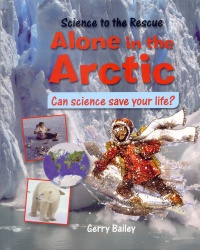 |
Alone in the Arctic: Can Science Save Your Life? (Science to the Rescue).
Gerry Bailey.
St. Catharines, ON: Crabtree, 2014.
32 pp., pbk., hc., pdf & html, $11.95 (pbk.), $21.56 (RLB.).
ISBN 978-0-7787-0434-8 (pbk.), ISBN 978-0-7787-0428-7 (RLB.), ISBN 978-1-4271-7546-5 (pdf), ISBN 978-1-4271-7540-3 (html).
Subject Heading:
Arctic regions-Juvenile literature.
Grades 3-6 / Ages 8-11.
Review by Barbara McMillan.
*** /4
|
| |
|
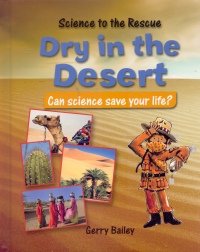 |
Dry in the Desert: Can Science Save Your Life? (Science to the Rescue).
Gerry Bailey.
St. Catharines, ON: Crabtree, 2014.
32 pp., pbk., hc., pdf & html, $11.95 (pbk.), $21.56 (RLB.).
ISBN 978-0-7787-0435-5 (pbk.), ISBN 978-0-7787-0429-4 (RLB.), ISBN 978-1-4271-7547-2 (pdf), ISBN 978-1-4271-7541-0 (html).
Subject Heading:
Deserts-Juvenile literature.
Grades 3-6 / Ages 8-11.
Review by Barbara McMillan.
*** /4
|
| |
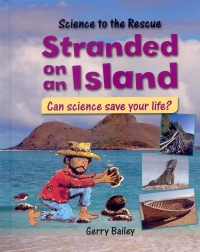 |
Stranded on an Island: Can Science Save Your Life? (Science to the Rescue).
Gerry Bailey.
St. Catharines, ON: Crabtree, 2014.
32 pp., pbk., hc., pdf & html, $11.95 (pbk.), $21.56 (RLB.).
ISBN 978-0-7787-0436-2 (pbk.), ISBN 978-0-7787-0430-0 (RLB.), ISBN 978-1-4271-7548-9 (pdf), ISBN 978-1-4271-7542-7 (html).
Subject Heading:
Islands-Juvenile literature.
Grades 3-6 / Ages 8-11.
Review by Barbara McMillan.
*** /4
|
| |
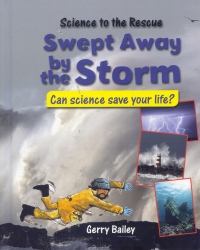 |
Swept Away by the Storm: Can Science Save Your Life? (Science to the Rescue).
Gerry Bailey.
St. Catharines, ON: Crabtree, 2014.
32 pp., pbk., hc., pdf & html, $11.95 (pbk.), $21.56 (RLB.).
ISBN 978-0-7787-0437-9 (pbk.), ISBN 978-0-7787-0431-7 (RLB.), ISBN 978-1-4271-7549-6 (pdf), ISBN 978-1-4271-7543-4 (html).
Subject Heading:
Oceanography-Juvenile literature.
Grades 3-6 / Ages 8-11.
Review by Barbara McMillan.
*** /4
|
| |
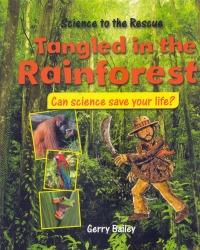 |
Tangled in the Rainforest: Can Science Save Your Life? (Science to the Rescue).
Gerry Bailey.
St. Catharines, ON: Crabtree, 2014.
32 pp., pbk., hc., pdf & html, $11.95 (pbk.), $21.56 (RLB.).
ISBN 978-0-7787-0438-6 (pbk.), ISBN 978-0-7787-0432-4 (RLB.), ISBN 978-1-4271-7550-2 (pdf), ISBN 978-1-4271-7544-1 (html).
Subject Heading:
Rain forests-Juvenile literature.
Grades 3-6 / Ages 8-11.
Review by Barbara McMillan.
*** /4 |
| |
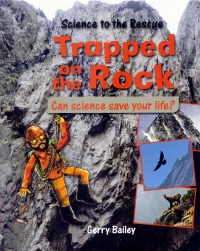 |
Trapped on the Rock: Can Science Save Your Life? (Science to the Rescue).
Gerry Bailey.
St. Catharines, ON: Crabtree, 2014.
32 pp., pbk., hc., pdf & html, $11.95 (pbk.), $21.56 (RLB.).
ISBN 978-0-7787-0439-3 (pbk.), ISBN 978-0-7787-0433-1 (RLB.), ISBN 978-1-4271-7551-9 (pdf), ISBN 978-1-4271-7545-8 (html).
Subject Heading:
Mountains-Juvenile literature.
Grades 3-6 / Ages 8-11.
Review by Barbara McMillan.
*** /4
|
| |

excerpt:
The Arctic has suffered more than any other part of the planet from global warming. The polar ice that makes up the whole region is melting so fast that it may all be gone in as little as twenty years. (From Alone in the Arctic, p. 22.)
Haboob – The haboob is a strong wind that causes sandstorms in the southern areas of the Sahara. It is usually followed by thunderstorms and even small tornadoes. A haboob usually lasts for around three hours and can carry large quantities of sand that move in a dense wall. The wall of sand can reach up to 3,200 feet (1,000 m) in height. (From Dry in the Desert, p. 9.)
The ocean floor has all the same features we see on land – valleys, mountains, and volcanoes – but they lie in the ocean depths and are mostly hidden from view. However, sometimes the peaks of underwater mountains rise above the waves. They form small islands, either on their own or in groups. The largest island in the world is Greenland. (From Stranded on an Island, pp. 6-7.)
When the wind passes over the surface of the ocean, it pulls at the water and causes the surface to move. The water close to the surface turns over in a circular movement, forming a rounded shape as it spins. Below the surface the circles of water sink deeper and dissolve. Close to the beach, the circling movement shows. The top part of the circle flows over the top and the wave breaks. (From Swept Away by the Storm, p. 17.)
The rainforests of Southeast Asia are the oldest rainforests on Earth, dating back 70 million years. But these vital jungles, teeming with exotic plants and animals, will be destroyed in the next 10 years, faster than the rainforests anywhere else. Illegal logging has led to a catastrophe, the scientists like Joe are warning us to take action. (From Trapped in the Rainforest, p. 28.)
Hi! My name is Joe, and I’ve just returned from another adventure. This time it happened in the mountains – high up on the craggy slopes. I was making my way over the rocks when there was a tremor. I’ll tell you about tremors later, but as I was standing there, the ground under my feet gave way. Down and down I went, until my guide rope tightened and I was hanging in the air. Well, I managed to get myself onto a ledge. Thanks to some great guides, animals, and people, along with all the science I know, I finally got back down to the valley. So let me tell you all about it. (From Trapped on the Rock, p. 5.)
In the “Science to the Rescue” series published by Crabtree, Gerry Bailey uses an uncommon, but interesting, approach in his attempt to answer the question, “Can science save your life?” He enlists the help of “Joe”, a fictional scientist-explorer, who is not your conventional, narrowly focused expert. Depending on the ecosystem in which Bailey situates Joe, he can be a paleontologist searching for the fossilized remains of ancient plants and animals, an archeologist searching the Sahara Desert for the lost city of Garama, a climatologist studying Arctic sea ice, a botanist searching for the seeds of rare island plants, or a zoologist investigating the relationship between forecasting storms at sea and the depth of water (distance from the coastline) in which young sharks are swimming. Using these ecosystems, and a rainforest, as a backdrop for adventure, Joe narrates stories about being stranded and rescued. Bailey interrupts these narratives with factual information about the particular ecosystem in which Joe’s adventure occurs. Readers will know whether the speaker is Joe or Bailey by the font used, the colour of the page on which each text is written, and the type of artwork. Joe’s font is larger and narrower (not bold), the background colour is a creamy tan (not white), and Leighton Noyes illustrates Joe’s stories with delightful, water colored, ink drawings (not stock photographs).
I was predisposed to like the six books in this series because of the use of the interrupted storyline. This a pedagogical approach in teaching science, particularly science teaching that incorporates historical narratives and interrupts these narratives with experimental (laboratory-based) work. It’s possible for readers to read each page of these books in succession or to go from page to page reading only about Joe’s adventure and then flipping to the beginning and looking more closely at the science that helps to explain Joe’s observations. For example, in Trapped on the Rock, Joe talks about the stretching and creasing over millions of years that caused the “rough, rugged shapes” and “cracks and crevices” of the mountains he was exploring. The pages in the book that precede and follow this portion of his story tell about tectonic plates, the causes of the different mountain shapes and strata, and the consequences of weathering and erosion. Both reading approaches are meaningful.
What’s surprising is Bailey’s inattention to the subtitle “Can Science Save Your Life?” In the majority of books in the series, it is not really science knowledge that helps Joe survive. In Alone in the Arctic, it is knowledge of the local culture – how Inuit build shelters of snow and how Inuit fish through a hole in the ice – that helps to sustain Joe’s life on the drifting ice. In reality, however, he would not have survived. Igloos require a special kind of snow that may not have been available to him, and he shares this shrinking, floating habitat with a walrus, “a family of seals, two snow geese, a snowy owl, and a polar bear.” The polar bear is a top carnivore in the Arctic. Similarly, in Dry in the Desert, it is not science that helps Joe to locate an oasis with an aquifer and edible date palms or that enables him to identify the location of his jeep buried in the sand. He is saved by fortuity and a nomadic tribe of Berber people, known as the Tuareg, who, like the Inuit, know well the land that sustains them.
In contrast, when Joe is “stranded on an island,” it is having read Dafoe’s Robinson Crusoe that informs him. However, the knowledge that underpins Joe’s search for coconuts, a nutritious foodstuff, how the coconut palm became established on the island, and Joe’s use of two sticks and dried grass to start a fire for cooking does result in simplified scientific explanations. One wishes that the connections between the knowledge needed to survive in particular ecosystems and scientific knowledge had been more fully developed in all six books.
As with all Crabtree series, each 32-page book contains a table of contents, a glossary of terms, short lists of books and websites that readers can access for additional information, and an index.
Recommended.
Barbara McMillan is a teacher educator and a professor of science education in the Faculty of Education, the University of Manitoba.

To comment on this title or this review, send mail to cm@umanitoba.ca.
Copyright © the Manitoba Library Association. Reproduction for personal use is permitted only if this copyright notice is maintained. Any
other reproduction is prohibited without permission.
CM Home |
Next Review |
Table of Contents for This Issue - December 5, 2014
| Back Issues | Search | CM Archive
| Profiles Archive
|





